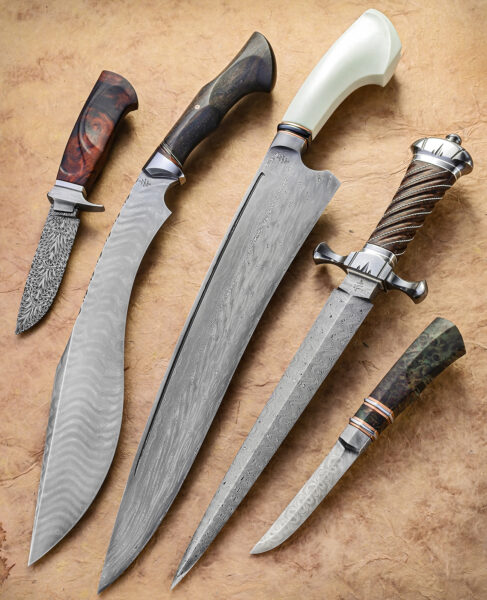My previous blog “How a Damascus Chef Knife Is Made” had a history of damascus along with how it generally was and now is made. This is a follow-up revisiting that history and showcasing my process of how I make a Damascus Chef Knife.
When it comes to it’s rich history, smiths halfway around the world had been producing patterns in steel for more than a thousand years by the time a crusader could admire a Syrian sword. I also mentioned that pattern welded steel blades date back to at least the 1st Century AD and had reached a very high level of skill and artistry by the year 300 or so. The techniques were primarily used to make swords and other important weapons, and there is not much evidence for ancient damascus chef’s knives.
As far back as our written records go, the two terms (“damascus” and “pattern welded steel”) have been used interchangeably by historians—the experts whose writings are the only records we have. This being the case, it is clear that the right way to treat the distinction between the two methods for producing patterns in steel is that both methods make materials called “damascus.” Not all damascus is wootz, just as not all damascus is pattern welded. My chef’s knives are made of pattern welded damascus. Perhaps I’ll make some out of wootz at some point to really confuse my visitors.

When it comes to my process, it starts with creating a billet that was made from two different sets of steels that were bound together into a packet. At 2000 degrees, I then heat that billet to be able to hammer the layers to weld together into a solid block of steel. This part of the process is called forge welding. That billet then gets hammered out into a long bar, which gets re-stacked so I can repeat the heating process until I have the number of layers that I am looking for. From there, I can begin adding the patterns. Those patterns can be anything from a family crest to a business logo. Here is also a brief visual look into how my knives are forged.
When visitors see my chef knives made of damascus, they will sometimes draw the distinction between “true” damascus and modern pattern weld for themselves. This distinction is popular amongst those who are historically curious and are interested in swords, knives, and weaponry. The deeper truth is that this distinction has been unclear since the very beginning.
Let’s also revisit some of the more detailed talking points of of my previous blog:
How Damascus IS Made
To describe this process as pattern welding feels comfortably accurate; the pattern is produced by forge welding two steels together. When I make damascus steel for a chef’s knife:
- I start with two different alloys of high carbon steel.
- I forge weld—fuse—them together into a single bar at very high temperatures.
- Then I manipulate and fold the bar (and thus the layers within the bar) to produce patterns using the contrasting appearance of the two different alloys.
How Damascus WAS made
When Syrian smiths began folding wootz, they most likely referred to it simply as steel, or wootz steel; it was just their way of making steel and steel items. But as it happens, the quality of the work they were able to produce with these methods was very high relative to other steels available at the time, so it began to build a reputation.
If a smith had made a chef’s knife out in Damascus, Syria 1000 years ago:
- He would have started with a type of small-batch smelted steel called “wootz,” or simply “crucible steel.”
- He would then forge out that ingot of steel and begin his own process of folding and manipulation as a way to refine and strengthen the steel.
- A pattern would emerge as a byproduct of this folding and forging.
Deciding on a pattern is where the collaboration between you as the client and myself. Commissions do start at $1000. If you are interested, and even have a vision of what you are looking for in a commission, fill out a contact form at JonasBlade.com to reach me.
Want extra inspiration? Come check out the damascus chef knives from Jonas Blade’s Collection made over the last 10+ years!
About The Author
Zack Jonas was born and raised in Massachusetts in the 1980’s and is still a New Englander today. With his growing love for art over the years, he took an introductory bladesmithing class at MASSart. It was there that he learned one of his most valuable lessons, which is that everyone has some insight worth learning. Today, he is a full-time bladesmith and feels incredibly fortunate to have found his calling.

